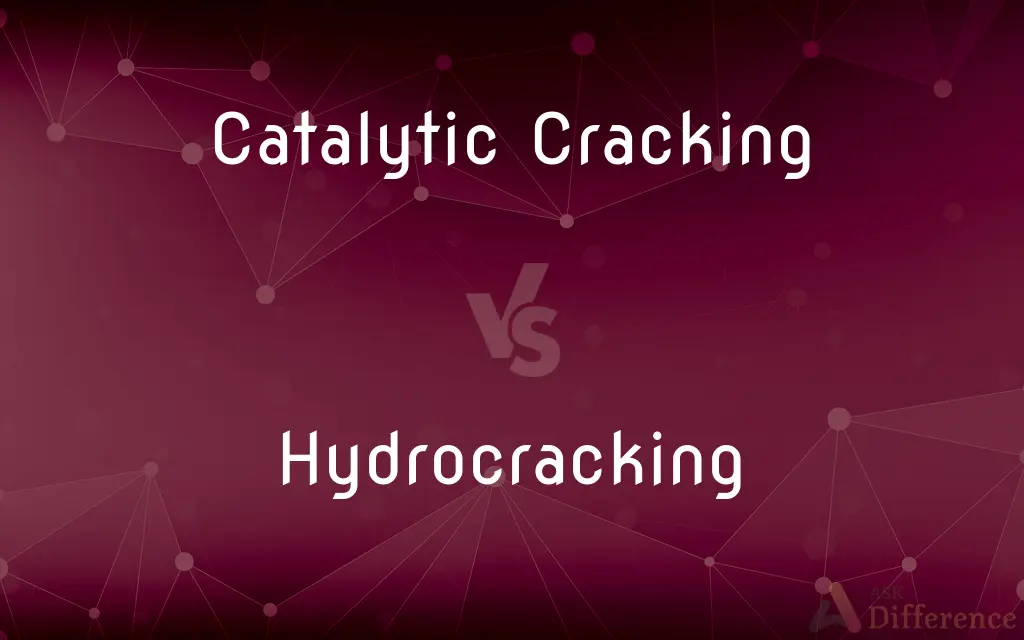Catalytic Cracking vs. Hydrocracking — What's the Difference?
By Tayyaba Rehman — Published on November 18, 2023
Catalytic Cracking uses a catalyst to break down large hydrocarbons into smaller molecules. Hydrocracking combines hydrogen with catalyst-driven breaking of hydrocarbons to create cleaner fuels.

Difference Between Catalytic Cracking and Hydrocracking
Table of Contents
ADVERTISEMENT
Key Differences
Catalytic Cracking is a crucial process in the oil and gas industry, involving the breakdown of complex hydrocarbon chains into simpler molecules. Hydrocracking, conversely, involves the use of hydrogen and a catalyst to achieve a similar breakdown, but with additional hydrogenation of the produced fractions.
Catalytic Cracking prominently employs a catalyst to facilitate the cracking of hydrocarbons, typically at high temperatures. Hydrocracking, contrastingly, occurs at high pressure, incorporating hydrogen into the reactions, and demands a distinct catalyst and operational conditions.
In Catalytic Cracking, various catalysts, like zeolites, are utilized to foster the fracture of larger hydrocarbons into more straightforward, often more volatile molecules. Hydrocracking, on the other side, employs different catalysts, commonly comprising metals like platinum or palladium, promoting both cracking and hydrogenation.
Catalytic Cracking is often specifically utilized to increase the production of gasoline in a refinery. In contrast, Hydrocracking is leveraged for producing cleaner, low-sulfur diesel fuels and is sometimes preferred in scenarios demanding extensive cracking and desulfurization.
Catalytic Cracking often sees use in Fluid Catalytic Cracking units where the catalyst is in a fluidized state to enhance contact with hydrocarbons. Hydrocracking, however, is usually employed in fixed bed or ebullated bed reactors due to the necessity of managing the required high hydrogen pressure efficiently.
ADVERTISEMENT
Comparison Chart
Basic Process
Breaks hydrocarbons with a catalyst.
Breaks and hydrogenates hydrocarbons with a catalyst.
Operating Conditions
Typically lower pressure, high temperature.
High pressure and temperature.
Primary Products
Often skewed towards gasoline.
Produces substantial diesel and naphtha.
Catalyst Used
Commonly zeolites.
Typically contains metals like platinum.
Sulfur Removal
Limited sulfur removal.
Significant sulfur and contaminant removal.
Compare with Definitions
Catalytic Cracking
It is primarily employed in refining processes to convert high-boiling, high-molecular weight hydrocarbons to valuable gasoline, olefinic gases, and other products.
The refinery improved profitability by enhancing their Catalytic Cracking processes.
Hydrocracking
Hydrocracking is typically conducted under high pressures, often between 100 and 200 bar.
The reactors used in Hydrocracking are designed to withstand remarkably high pressures.
Catalytic Cracking
The process is crucial in petrochemical production, producing key feedstocks and fuel components.
Catalytic Cracking units are pivotal for meeting the demand for petrochemical feedstocks.
Hydrocracking
Hydrocracking is a refinery process that employs hydrogen and a catalyst to break and hydrogenate hydrocarbon chains.
Hydrocracking plays a vital role in producing cleaner diesel fuels.
Catalytic Cracking
This method uses a variety of catalysts, such as zeolites, to facilitate the cracking process.
Scientists are exploring new catalysts to improve the efficiency of Catalytic Cracking.
Hydrocracking
The process involves catalysts, often containing metals like palladium or platinum, to facilitate cracking and hydrogenation.
Maintaining the activity of the metal catalysts is crucial for the efficient operation of Hydrocracking.
Catalytic Cracking
Catalytic Cracking occurs at elevated temperatures, often between 450 and 750 degrees Celsius.
Managing the temperature is crucial in ensuring optimal outcomes in Catalytic Cracking.
Hydrocracking
Hydrocracking enables the conversion of heavier crude oil fractions into lighter, more valuable products, including naphtha and diesel.
Hydrocracking units are increasingly essential due to the prevalence of heavier crude oil sources.
Catalytic Cracking
Catalytic Cracking facilitates the breaking of larger hydrocarbon chains into smaller, often more valuable, molecules using a catalyst.
Catalytic Cracking is essential for optimizing the yield of gasoline from crude oil.
Hydrocracking
This method significantly reduces the sulfur content in the resulting hydrocarbon products.
Environmental regulations often necessitate the use of Hydrocracking due to its desulfurizing capabilities.
Hydrocracking
A process by which the hydrocarbon molecules of petroleum are broken into simpler molecules, as of gasoline or kerosene, by the addition of hydrogen under high pressure and in the presence of a catalyst.
Hydrocracking
(organic chemistry) the production of high-octane petroleum fuel and kerosene by hydrogenating large or complex hydrocarbons and then cracking them.
Hydrocracking
Present participle of hydrocrack
Hydrocracking
The process whereby hydrocarbon molecules of petroleum are broken down into kerosene and gasolene by the addition of hydrogen under high pressure in the presence of a catalyst
Common Curiosities
Why is Hydrocracking often associated with cleaner fuel production?
Hydrocracking is associated with cleaner fuel due to its capability to produce low-sulfur products and its role in producing cleaner-burning diesel fuels.
Can Catalytic Cracking assist in producing diesel fuel?
Yes, while it's often associated with gasoline production, Catalytic Cracking can also yield diesel fractions depending on the operating conditions and feedstock.
How does Hydrocracking differ from Catalytic Cracking in terms of hydrogen use?
Hydrocracking utilizes hydrogen to break down and hydrogenate hydrocarbons, while Catalytic Cracking doesn't use hydrogen in the cracking process.
How does the product distribution differ between Catalytic Cracking and Hydrocracking?
Catalytic Cracking generally yields more gasoline fractions, while Hydrocracking tends to produce more diesel and is capable of handling heavier feedstocks.
Is there a significant cost difference between Catalytic Cracking and Hydrocracking?
Yes, the cost can differ significantly due to the varying operational conditions, catalyst types, and infrastructure needed, with Hydrocracking often being more capital intensive.
Why are different catalysts used in Catalytic Cracking and Hydrocracking?
Different catalysts are used due to the distinct reactions and conditions present in each process, such as pressure, temperature, and the involvement of hydrogen.
How does the pressure in Hydrocracking compare to Catalytic Cracking?
Hydrocracking generally operates at much higher pressures compared to Catalytic Cracking to facilitate hydrogen incorporation.
What is the primary objective of Catalytic Cracking in refineries?
Catalytic Cracking aims to break down larger hydrocarbon molecules into smaller, valuable products like gasoline and olefins using catalysts.
How do refineries choose between implementing Catalytic Cracking or Hydrocracking?
Refineries choose based on various factors including desired products, available feedstock, environmental regulations, and operational capabilities.
Why is temperature management crucial in Catalytic Cracking?
Temperature management is vital in Catalytic Cracking to ensure the efficiency of the cracking reactions and prevent the deactivation of the catalyst.
How does feedstock type influence the choice between Catalytic Cracking and Hydrocracking?
Heavier, more sulfur-containing feedstocks might be better suited for Hydrocracking due to its desulfurization capabilities, while lighter feedstocks can be efficiently processed with Catalytic Cracking.
Which method is more effective for sulfur removal from hydrocarbon streams?
Hydrocracking is typically more effective in removing sulfur due to the hydrogenation of sulfur compounds.
Can zeolites be used as catalysts in Hydrocracking?
Zeolites can be used in Hydrocracking, often in conjunction with metal catalysts, to facilitate both cracking and hydrogenation reactions.
What are the environmental implications of Catalytic Cracking?
Catalytic Cracking can have environmental implications, such as emissions from the process, and the need for effective catalyst management and disposal.
Can the processes be used in tandem within a single refinery?
Yes, Catalytic Cracking and Hydrocracking can be used in tandem to optimize product yields based on specific feedstocks and market demands.
Share Your Discovery

Previous Comparison
All-Season Tires vs. All-Terrain Tires
Next Comparison
DNS vs. DHCPAuthor Spotlight
Written by
Tayyaba RehmanTayyaba Rehman is a distinguished writer, currently serving as a primary contributor to askdifference.com. As a researcher in semantics and etymology, Tayyaba's passion for the complexity of languages and their distinctions has found a perfect home on the platform. Tayyaba delves into the intricacies of language, distinguishing between commonly confused words and phrases, thereby providing clarity for readers worldwide.












































